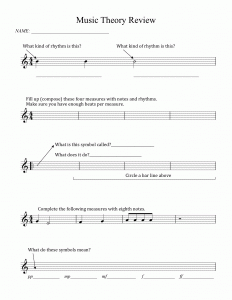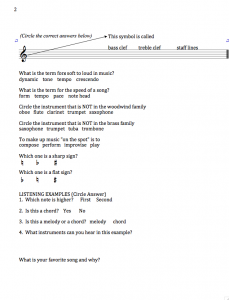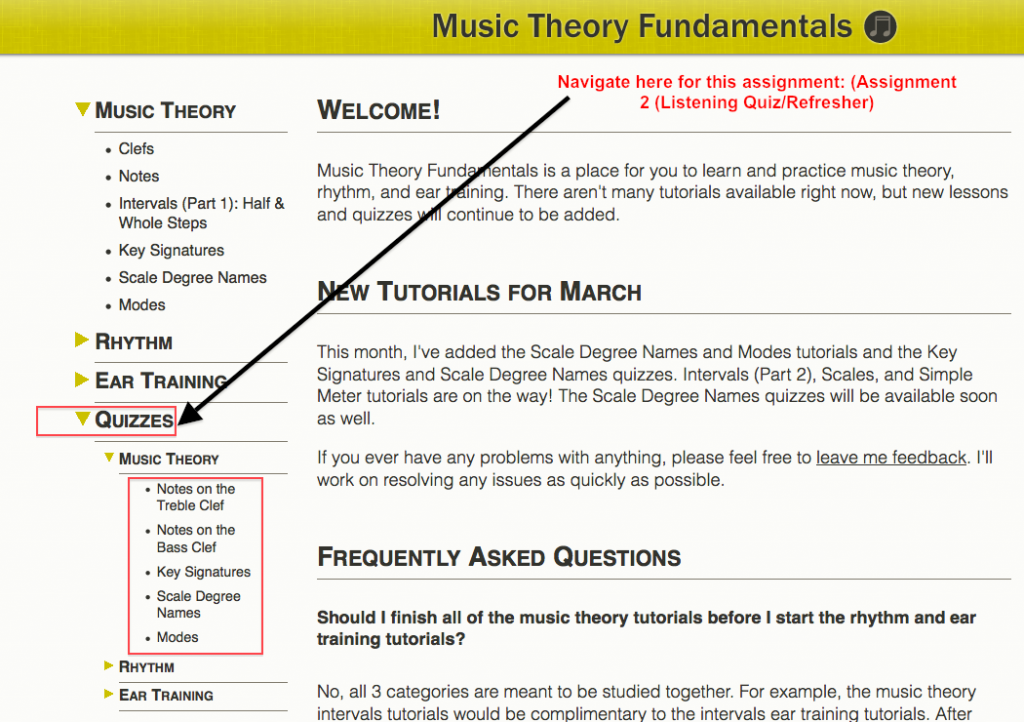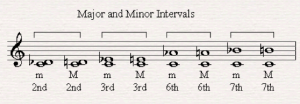Prompt 1: Theory Review Sheet
- Complete the attached theory review sheet/questionnaire before next class (also handout out on Tuesday).
- Use your textbook for reference if necessary.
- We will complete the listening portion in class.
DUE DATE: 9/10/2015
—————————————————————————————————————————–
Prompt 2: Theory Fundamentals (Online Quizzes)
Go to Music Theory Fundamentals and complete the quizzes below. Record your answers (right or wrong). We will go over each quiz during class.
*Answer each question once, record your answer, then check for correctness
Quizlet Music Vocabulary Review Here. Use the scatter function to test your knowledge.
DUE DATE: 9/17/2015
——————————————————————————————————————————————————————–
Prompt 3: Interval Identification
Complete the following listening items by identifying the intervals on a piece of music paper (bring to class). Note your first instinct answer first. Then, you can sit at a piano (or other instrument) to identify the interval.
Example 1 (Name this interval)
- Answer________________________________________
Example 2 (Name this interval)
- Answer________________________________________
Which note is lower (first or second) in this example?
- Answer________________________________________
Example 3 (Name this interval)
- Answer________________________________________
Which note is higher (first or second) in this example?
- Answer_________________________________________
DUE DATE: 9/24/2015 (On Piece of Music Paper With Your Name)
——————————————————————————————————————————————————————–
Prompt 4: Major Scale Construction
Watch the first two minutes of this video.
- Write your answers on a piece of music sheet paper and bring it to class.
- What is the formula for a major scale?
- Pick two other scales and write out their formulas (Example: pentatonic, melodic minor, harmonic minor, etc.)
- Create your own scale formula
DUE DATE: 10/1/2015
——————————————————————————————————————————————————————–
Prompt 5: Practice Test
Instruments:
Match the following words with the correct equivalents:
a.Woodwind 1. oboe
b Brass 2. violin
c.Strings 3. trombone
d.Percussion 4. harpsichord
e.Keyboard 5. clarinet
a-b.Plucked Strings 6. saxophone
- flute
- lute
- bassoon
- french horn
- viola
- trumpet
- guitar
- cello
- piano
Elements:
Fill in the correct answer to the following questions or statements.
- The movement of music through time and the aspect of time in music is called___________
- A regular recurring time unit that represents the pulsation of the music is called____________.
- In triple meter, the strongest pulse occurs on____________
- The shifting of the accent to a weak beat or an offbeat is called_______________.
- A complete musical idea or section within a larger melodic line is called____________.
- The first note of a scale is what?_______________.
- What term describes a combination of tones that sound at rest, resolved and in agreement? _________________
- A combination of tones that sound tense, unstable and in need of resolution is called_________________.
- The aspect of music that reveals the relationship of the musical lines and how the blend to create the musical fabric is called______________.
- The rate of speed at which a piece of music is played is its_____________.
- In what language are tempo markings generally given? ______________.
- Accelerando is a term indicating that the speed of the music is________________.
- The degree of loudness or softness at which music is played is called______________.
- The term timbre refers to?_____________.
- Which of the following markings is the softest?
- a. pianissimo,
- b. piano,
- c. mezzo piano,
- d. mezzo forte
- The standard ranges of the human voice from top to bottom are____________.
- Woodwind instruments are so called because? ____________
- The highness or lowness of a sound is determined by:
- Which of the following is true?:
- a. all tunes are melodies
- c. all melodies are tunes
- b. all motives are tunes
- d. all phrases are themes
- A melodic pattern of pitches repeated at a different pitch level is called a________
- Another word for polyphony is______________
- Individual movements of music are often referred to by their________________
- The two modes or scales that have survived through out the ages and are used for composing most music from 1600-1900 are__________________.
- A meter with some aspects of duple in the foreground and at the same time a triple in the back ground would be an example of_________________
- The mechanical device that measures the number of beats per minute is known as a __________________
- An accent is________________
- A gradual slowing in a musical passage is known as _____________
- One single melody played or sung without accompaniment is said to be in what texture?__________________
- A melody with other supporting sounds markedly subsidiary is in what texture? __________________
- In imitative counterpoint the voices do what?
- The form that is diagramed ABA, and contains a departure and then a return of the first section is called____________________.
- The form that is diagramed ABACADA, and contains a periodic return of a central theme is called_______________.
True or False Questions
- Tempo refers to the speed of a piece of music.
- Harmony is the successive sound of individual pitches.
- Consonant harmonies are more stable than dissonant harmonies.
Match the following words with the correct equivalents
- largo 51. very loud
- adagio 52. allegro
- piano 53. loud
- fast 54. slow
a-b. moderately slow, (at a walking pace) 55. soft
b-c. pp 56. medium loud
c-d. mf 57 very soft
d-e. very fast 58. presto
a-e. f 59. andante
a-c fortissimo (ff) 60. very slow
DUE DATE: 10/8/2015







